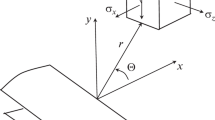Abstract
Prediction of the angle of initial crack extension, critical load and unstable crack paths based on the criteria of maximum tangential stress (MTS), maximum tangential principal stress (MTPS), maximum tangential strain (MTSN), and strain energy density (SED) are compared for slit and elliptical cracks under pure shear loading and elliptical cracks under uniaxial compressive loading. Results presented here complement those in Part I of this investigation. Some of the theoretical predictions have been compared with data available in the literature.
All the four criteria are found to be more or less equally applicable in the cases studied for the prediction of direction of initial crack extension and critical load. The unstable crack paths based on the four criteria differ, the difference being greatest for the SED criterion. Some difficulties are found on applying this criterion to some situations.
Résumé
On considère des fissures en entaille et elliptiques soumises à des charges de cisaillement pur et des fissures elliptiques soumises à des charges de compression uniaxiale. On établit une comparaison des prédictions de l'angle d'extension initiale de la fissure, de la charge critique et des chemins de fissuration instables, en se basant sur les critères de la tension tangentielle maximale, de la tension principale tangentielle maximale, de la déformation tangentielle maximale et de la densité d'énergie de déformation. Les résultats présentés ici constituent un complément à ceux présentés dans la première partie de cette investigation. Certaines des prédictions théoriques ont été comparées avec des données disponibles dans la littérature.
On montre que les quatre critères peuvent être appliqués de manière plus ou moins indifférente dans les cas étudiés pour prédire la direction de l'extension uniaxiale de la fissure ainsi que la charge critique. Néanmoins, les chemins de fissuration instables diffèrent selon les critères utilisés. La différence étant la plus grande dans le cas du critère de densité d'énergie de déformation. On trouve certaines difficultés à appliquer ce critère à certaines situations.
Similar content being viewed by others
References
F. Erdogan and G.C. Sih,Transactions of ASME., Journal of Basic Engineering 85D (1963) 519–527.
J.G. Williams and P.D. Ewing,International Journal of Fracture Mechanics,8, 4 (1972) 441–446.
H.-C. Wu,Journal of the Engineering Mechanics Division of ASCE 100 (1974) 1167–1181.
G.C. Sih,Mechanics of Fracture (Editor-G.C. Sih), Noordhoff International Publishing, Leyden, 1 (1973) XXI-XLV.
S.K. Maiti and R.A. Smith,International Journal of Fracture 23 (1983) 281–295.
M.E. Kipp and G.C. Sih,International Journal of Solids and Structures 11 (1975) 153–173.
S.K. Maiti, “Unstable Edge Crack Extension During Shearing of Bars,” Ph.D. Thesis, IIT, Bombay (1979).
S.K. Maiti,Journal of Strain Analysis 15, 4 (1980) 183–194.
S.K. Maiti and K.S.R.K. Prasad,International Journal of Solids and Structures 16 (1980) 563–574.
K.J. Chang,Journal of Applied Mechanics 49 (1982) 377–382.
S.K. Maiti and R.A. Smith,International Journal of Fracture 23 (1983) R41-R44.
P.D. Ewing and J.G. Williams,International Journal of Fracture 10 (1974) 537–544.
A.F. Liu,AIAA Journal 12 (1974) 180–185.
K.J. Chang,Engineering Fracture Mechanics 14 (1981) 125–142.
K.J. Chang,Engineering Fracture Mechanics 14 (1981) 107–124.
B. Cotterell,International Journal of Fracture 8 (1972) 195–208.
H.-C. Wu and K.J. Chang,Transactions of ASME, Journal of Applied Mechanics 45, 2 (1978) 258–262.
J.L. Swedlow, ASTM, STP 601 (1976) 506–521.
E. Hoek and Z.T. Bieniawski,International Journal of Fracture 1 (1965) 137–155.
R.V. Goldstein and R.L. Salganik,International Journal of Fracture 10 (1974) 507–523.
B. Cotterell and J.R. Rice,International Journal of Fracture 16, 2 (1980) 155–169.
Author information
Authors and Affiliations
Rights and permissions
About this article
Cite this article
Maiti, S.K., Smith, R.A. Comparison of the criteria for mixed mode brittle fracture based on the preinstability stress-strain field. Int J Fract 24, 5–22 (1984). https://doi.org/10.1007/BF00020264
Received:
Issue Date:
DOI: https://doi.org/10.1007/BF00020264




